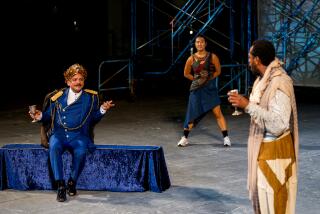Paul Mellon Never Let Ego Overshadow Generosity
- Share via
If you never heard Paul Mellon’s name until this week, when the billionaire philanthropist, art collector and environmentalist died at his Virginia estate at the age of 91, it would have been just fine by him. Privacy, not celebrity, was what he craved.
Son of the legendary financier and U.S. Secretary of the Treasury Andrew Mellon (1855-1937), young Paul grew up with enormous privilege and the undisputed wherewithal to make a big difference in many spheres of American life. But, in a rare stroke of luck, he seems to have been spared that distinctly modern gene that drives (mostly) men to want to see their names up in lights, plastered all over their good deeds in a stunning public display of gross personal insecurity.
Paul Mellon did endless good deeds throughout his long life, but you have to look very hard to find his name displayed in their vicinity.
No big billboard announces a “Paul Mellon Stretch of Cape Hatteras National Shoreline” in North Carolina or a “Mellon Family Great Beach” on Cape Cod, even though his money and influence were responsible for the preservation and protection of these public parks. Although he gave nearly 1,000 works to Washington’s National Gallery of Art--paintings by Cezanne, David, Gericault, Picasso, Manet, Homer, Rothko, Degas, Van Dyck--and served intermittently as a trustee between 1938 and 1985, huge gold letters are nowhere etched into eternal stone to trumpet for the ages the Paul Mellon Collection.
Nor does the National Gallery boast a Paul and Ailsa Mellon East Wing, although he financed (to the tune of more than $90 million) with his sister the construction of the I.M. Pei-designed addition. And no one has ever visited the Paul Mellon-Yale Center for British Art, founded, built, endowed and provided with a sizable core collection by the man. He refused to have his name above the title, just as his father had done 40 years before when he gave an astonishing gift of art (Raphael, Botticelli, Van Eyck), money and a building by John Russell Pope to establish the National Gallery of Art.
Neither was there any indication that Mellon made these big philanthropic gestures out of a sense of noblesse oblige, rooted as that sentiment is in a rather unctuous faith in the superiority of one’s inheritance and bank account. (As artist Larry Johnson put it in a memorable print, “Noblesse, oh please!”) Mellon plainly felt obliged, but noblesse seems to have had nothing to do with it.
He had gone to all the “right” schools--Choate, Yale, Cambridge--that a young man of privilege and prospects might be expected to attend, and it would be easy to look through a distorted lens at his love of breeding horses and passion for British art and mistake them for an American yearning for the trappings of a European aristocratic class. As a baby he had even been baptized in St. George’s Chapel at Windsor Castle.
But, observing from afar, it never seemed that way to me. After all, even Britain’s aristocracy doesn’t possess Mellon’s kind of passion for British art.
Nor, I confess, do I, save for the odd artist here and there over the centuries. But Mellon did, and that’s pretty much the point. He was crazy for George Stubbs, the largely self-taught 18th century portraitist of animals (and, on occasion, people), whose elegantly designed horse picture, “Pumpkin With Stable Lad Up,” began Mellon’s collecting life in 1934. The early infatuation with Stubbs grew to encompass the full panorama of English art--not just Reynolds, Hogarth, Constable and other big names, but more obscure figures like James Seymour, Charles Brooking and Arthur Devis.
When Mellon decided in 1966 to donate his British collection (it had mushroomed over 30 years to become the largest outside England) to his alma mater, Yale, to form the core of a research institute, and hired the brilliant American architect Louis Kahn to design a lovely, light-filled building (it opened in 1977), there was never any question that the benefactor’s name would not be attached to the center. Yes, there was the practical precedent of his father and the founding of the National Gallery (the elder Mellon had worried that potential donors would shy away from making gifts to a fledgling museum that featured someone else’s name over the door). Certainly the son hoped other magnanimous citizens would someday assist the Yale Center for British Art, the way they had the National Gallery.
But another factor of equal significance also seems likely. For this was a man who loved art--the sensual, emotional, spiritual and intellectual encounter with paintings and sculptures--and I suspect he didn’t want anything to get in the way of anyone else’s like-minded pleasure. The Yale Center for British Art would have been a failure if the most prominent reaction of a visiting public had been the declaration, “Wow! Look what Paul Mellon did!,” instead of, “Wow! Look what George Stubbs did!” For what Stubbs did was the crux of the matter.
Self-effacement in the service of public interaction with art is not high on many benefactors’ philanthropic lists today. In our museums, the 20th century cult of personality has finally culminated in that most vulgar of philanthropic enticements, the “naming opportunity,” wherein any coldblooded infusion of cash will get your moniker emblazoned on the wall high above the artists’ names.
In this regard Paul Mellon was not a man of his time. Self-effacement in the public service of art was his modus operandi. There’s deep satisfaction in knowing that this determined habit of standing happily in the background finally makes him stand out.
More to Read
The biggest entertainment stories
Get our big stories about Hollywood, film, television, music, arts, culture and more right in your inbox as soon as they publish.
You may occasionally receive promotional content from the Los Angeles Times.











